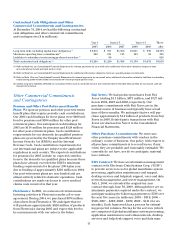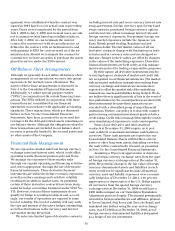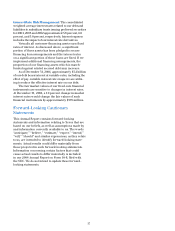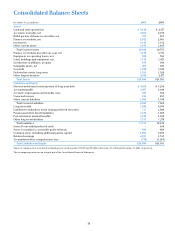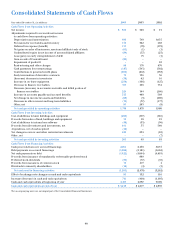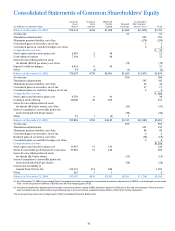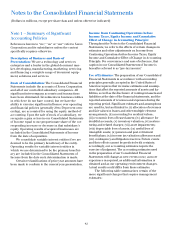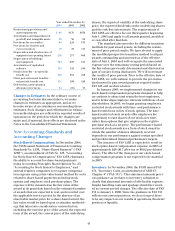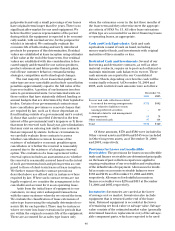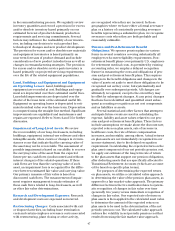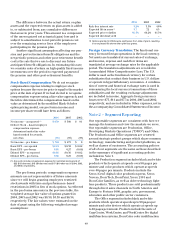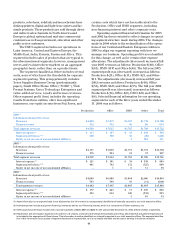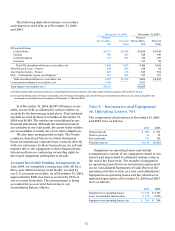Xerox 2004 Annual Report Download - page 47
Download and view the complete annual report
Please find page 47 of the 2004 Xerox annual report below. You can navigate through the pages in the report by either clicking on the pages listed below, or by using the keyword search tool below to find specific information within the annual report.
45
Service: Service revenues are derived primarily
from maintenance contracts on our equipment sold
to customers and are recognized over the term of the
contracts. A substantial portion of our products are sold
with full service maintenance agreements for which
the customer typically pays a base service fee plus a
variable amount based on usage. As a consequence,
other than the product warranty obligations associated
with certain of our low end products in the Office
segment, we do not have any significant product
warranty obligations, including any obligations under
customer satisfaction programs. Revenues associated
with professional and value-added services are
generally recognized as services are performed.
Supplies: Supplies revenue generally is recognized
upon shipment or utilization by customer in
accordance with sales terms.
Revenue Recognition Under Bundled Arrangements:
We sell most of our products and services under
bundled lease arrangements, which typically include
equipment, service, supplies and financing components
for which the customer pays a single negotiated fixed
minimum monthly payment for all elements over the
contractual lease term. These arrangements typically
also include an incremental, variable component for
page volumes in excess of contractual page volume
minimums, which are often expressed in terms of price
per page. The fixed minimum monthly payments are
multiplied bythe number of months in the contract
term to arrive at the total fixed minimum payments that
the customer is obligated to make (“fixed payments”)
over the lease term. The payments associated with page
volumes in excess of the minimums are contingent on
whether or not such minimums are exceeded (“contin-
gent payments”). The minimum contractual committed
page volumes are typically negotiated to equal the cus-
tomer’s estimated page volume at lease inception. In
applying our lease accounting methodology, we consid-
er the fixed payments for purposes of allocating to the
relative fair value elements of the contract. We do not
consider the contingent payments for purposes of allo-
cating to the elements of the contract or recognizing
revenue on the sale of the equipment, given the inher-
ent uncertainties as to whether such amounts will ever
be realized. Contingent payments are recognized as
revenue in the period when the customer exceeds the
minimum copy volumes specified in the contract.
Revenues under bundled arrangements are allo-
cated considering the relative fair values of the lease
and non-lease deliverables included in the bundled
arrangement based upon the estimated relative fair
values of each element. Lease deliverables include
maintenance and executory costs, equipment and
financing, while non-lease deliverables generally con-
sist of the supplies and non-maintenance services. Our
revenue allocation for the lease deliverables begins by
allocating revenues to the maintenance and executory
costs plus profit thereon. The remaining amounts are
allocated to the equipment and financing elements. We
perform extensive analyses of available verifiable
objective evidence of equipment fair value based on
cash selling prices during the applicable period. The
cash selling prices are compared to the range of values
included in our lease accounting systems. The range of
cash selling prices must be reasonably consistent with
the lease selling prices, taking into account residual
values that accrue to our benefit, in order for us to
determine that such lease prices are indicative of fair
value. Our pricing interest rates, which are used to
determine customer lease payments, are developed
based upon a variety of factors including local prevail-
ing rates in the marketplace and the customer’s credit
history, industry and credit class. Effectivein 2004,
our pricing rates are reassessed quarterly based on
changes in local prevailing rates in the marketplace
and are adjusted to the extent such rates vary by twenty-
five basis points or more, cumulatively, from the last
rate in effect. The pricing interest rates generally equal
the implicit rates within the leases, as corroborated by
our comparisons of cash to lease selling prices.
Revenue Recognition for Leases: Our accounting for
leases involves specificdeterminations under SFAS No.
13, which often involve complex provisions and signifi-
cant judgments. The twoprimary criteria of SFAS No.
13 which weuse to classify transactions as sales-type
or operating leases are (1) a review of the lease term to
determine if it is equal to or greater than 75percent of
the economic life of the equipment and (2) a reviewof
the present value of the minimum lease payments to
determine if they are equal to or greater than 90 per-
cent of the fair market value of the equipment at the
inception of the lease. Our sales-type lease portfolios
contain only normal credit and collection risks and
have no important uncertainties with respect to future
costs. Our leases in our Latin America operations
have historically been recorded as operating leases
given the cancellability of the contract or because the
recoverability of the lease investment is deemed not
to be predictable at lease inception.
The critical elements that we consider with
respect to our lease accounting are the determination
of the economic life and the fair value of equipment,
including the residual value. For purposes of
determining the economic life, we consider the most
objective measure to be the original contract term,
since most equipment is returned by lessees at or near
the end of the contracted term. The economic life of
most of our products is five years since this represents
the most frequent contractual lease term for our princi-


